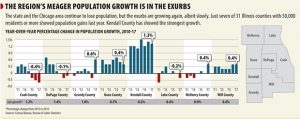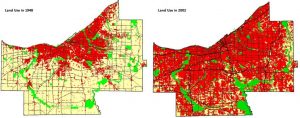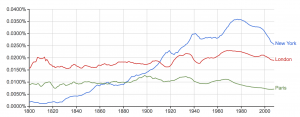Universities and health care, "eds and meds", have been in a huge growth cycle over the last few decades. Many communities have been pinning their hopes on anchor institutions like a university or research hospital to retool their economies for the 21st century. Yet the higher education industry is facing a convergence of several trends and forces that are threaten their future. At a minimum, schools need to be figuring out how to navigate these choppy waters ahead. Here are six forces converging on colleges today and in the near … [Read more...]
Ranking Smaller College Towns
I recently revisited Bloomington, Indiana (home of Indiana University, my alma mater) and Charlottesville, VA (home of the University of Virginia). They got me thinking about college towns, so I pulled some data for various of them in this size class. These are communities roughly in the 125,000-250,000 population range that are home to major flagship (or similar) universities. I have 11 on my list. For this size class of community, I believe the best unit of analysis is the county. These are metro areas and can have outlying counties. But … [Read more...]
Sprawl Without Growth, Chicago Edition
I recently posted about sprawl in its purest form in Cleveland. Cuyahoga County massively expanded its urbanized footprint while the population remained the same. A couple of recent articles from Crain's Chicago highlight the same thing happening in that city - with the same results in terms of negative filtering of homes and stagnant to declining housing prices. Metro Chicago has lost population for the last two years. But a better way to characterize it is stagnant. The population shrinkage is tiny. On the other hand, the growth that … [Read more...]
Sprawl In Its Purest Form, Cleveland Edition
Jason Segedy tweeted the image below contrasting the amount of urbanized land in Cleveland's Cuyahoga County in 1948 vs. 2002. The county population was identical in both years: 1.39 million. I'm not a hater on suburbanization. Growing populations require new urbanized land on the fringes. But when population growth is flat or negative in a region, which is the case in Cleveland and many Rust Belt cities, then sprawl has negative effects. One of the them is the Chuck Banas quip that Buffalo has the same number of people, but three … [Read more...]
The Rise and Fall of Cities in Books
Google Books' ngram tool lets you search and compare mentions of various terms in books that they've digitized. I ran some city names through it to see how the relative level of mentions of these places has changed over time. These aren't perfect. Some city names are too generic to really isolate, like Columbus (could refer to Christopher) or Charlotte (a common name). Others I assumed do typically refer to the major city of that name, but have other uses as well (Paris, St. Louis). Also, these are English language city name searches, and I'm … [Read more...]
The College Shakeout: Illinois Spotlight
My post about how colleges are diverging into winners and losers drew a ton of excellent comments you should read. phelmon64 led off by saying: It’s becoming clear that the distance between the various higher education tiers is getting wider. Ivies at the top, Ivy-equivalent private schools next, followed by public elites, small private liberal arts schools, big public/land grant schools — and then the rest. At some point states can (and must) do their share to help the public elites and land grant types, but I’m concerned about the future for … [Read more...]
US Colleges Diverging Into Winners and Losers, Shakeout Coming
The Wall Street Journal has been doing great work digging into the pending crisis hitting may colleges, particularly small non-selective liberal arts schools. In today's paper they have a piece on colleges sorting into winners and losers: The diverging fortunes help explain how U.S. higher education is shifting. For generations, a swelling population of college-age students, rising enrollment rates and generous student loans helped all schools, even mediocre ones, to flourish. Those days are ending. According to an analysis of 20 years of … [Read more...]
Inclusionary Zoning Flops in Portland
As the price of housing continues to rise in many cities, one popular progressive policy idea to address it is inclusionary zoning. Inclusionary zoning requires that a certain percentage of units in a building be priced at below market, targeted at people who earn some fraction of the area median income. Often this set aside is required in exchange for density bonuses or other things the developer might want. Portland passed one of these, and according to a report in the Portland Mercury, construction fell off a cliff: A year ago, Portland … [Read more...]
The Strange Case of Civic Identity in Northeast Ohio
I was recently in Akron presenting a forthcoming paper of mine. One of the interesting things about the Northeast Ohio constellation of cities is that there's a very weak sense of regional identity. In almost any other context, Cleveland and Akron would be considered some type of twin city ecosystem. Consider: Dallas and Ft. Worth are 32 miles apart. Seattle and Tacoma are 34 miles about. Cleveland and Akron are 39 miles apart. Cleveland's Cuyahoga County and Akron's Summit County are also physically contiguous. Yet, Cleveland … [Read more...]
Chicago’s $600 Million in Protein Bars
Crain's Chicago reports that a local protein bar company called RxBar is being acquired by Kellogg's for $600 million. RxBar was started by some friends in their early 30s with $10,000 in funds. They initially built it out of their parent's suburban kitchen, then into a commercial space in the city. They now have $120 million in revenue, employ 75, are hiring 40 more, and the owners (and any later investors they may have) are about to become spectacularly rich: Four years ago, Peter Rahal was making protein bars in his parents' Glen Ellyn … [Read more...]
- « Previous Page
- 1
- …
- 5
- 6
- 7
- 8
- 9
- …
- 32
- Next Page »









